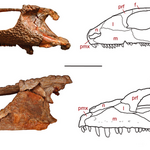Paleontology

The 'dinosaurs became birds' evidence just got lot a little stronger. Except they were more like diving waterfowl than the land-based kind.
A University of Manchester team, comprising biologists and palaeontologists, has found that theropod dinosaurs like the Velociraptor had similar respiratory systems to present-day diving birds, such as marine birds.
The findings, published in the Proceedings of the Royal Society B: Biological Sciences, present for the first time an explanation of how these dinosaurs may have breathed.
“A number of studies have shown that dinosaurs were the direct…

A team of Chinese and American scientists has discovered a new mammal from the 165 million-year-old lakebeds of the Jurassic Period in Northern China.
The find is reported in the November 1st issue of the journal Nature. It sheds light on the earliest mammalian evolution, especially the convergent evolution of teeth among early mammals, and leads scientists to think that mammals were far more diverse in the age of dinosaurs than previously thought.
"This discovery indicates that Jurassic mammals had achieved far more complex dentition than believed, suggesting that mammals diversified much…

Scientists have described the oldest definitive jellyfish ever found, using recently discovered "fossil snapshots" found in rocks more than 500 million years old.
The jellyfish are unique because they push the known occurrence of jellyfish back from 300 million to 505 million years.
"This study clearly shows what paleontologists have long suspected--that jellyfish have a history that's much older than their known fossil record," said Patrick Herendeen, program director in the National Science Foundation (NSF)'s division of environmental biology, which funded the research through the Assembing…

Unprecedented fossilized body imprints of amphibians have been discovered in 330 million-year-old rocks from Pennsylvania. The imprints show the unmistakably webbed feet and bodies of three previously unknown, foot-long salamander-like critters that lived 100 million years before the first dinosaurs.
"Body impressions like this are wholly unheard of," said paleontologist Spencer Lucas, a curator at the New Mexico Museum of Natural History and Science. Lucas will present the discovery on Tuesday, 30 October 2007, at the annual meeting of the Geological Society of America in Denver.
The…

The first fossil tracks belonging to large, carnivorous dinosaurs discovered in Victoria, Australia show that large dinosaurs were living in a polar environment during the Cretaceous Period, when Australia was still joined to Antarctica and close to the South Pole.
The find is being reported today, Friday, Oct. 19, at the Society of Vertebrate Paleontology meeting in Austin, Texas, by Anthony Martin, senior lecturer in environmental studies at Emory. Martin researched the find with Patricia Vickers-Rich and Lesley Kool of Monash University and Thomas Rich of the Museum of Victoria.
The three…

The newest dinosaur species to emerge from Grand Staircase-Escalante National Monument had some serious bite, according to researchers from the Utah Museum of Natural History (UNMH) at the University of Utah. “It was one of the most robust duck-billed dinosaurs ever,” said lead author Terry Gates. “It was a monster.”
Researchers from the Utah museum, the national monument and California’s Raymond M. Alf Museum of Palaeontology unearthed fossils of this ancient plant-eater from the rocks of the Kaiparowits Formation. Researchers announced the name of the creature – Gryposaurus monumentensis. (…

Sometimes it takes two decades to identify something but the wait is worth it. A dinosaur skeleton found 24 years ago in Montana has finally been identified as a new species that links North American dinosaurs with Asian dinosaurs. The dinosaur would have weighed 30 to 40 pounds, walked on two feet and stood about three feet tall. The fossil came from sediment that's about 80 million years old.
Jack Horner said he found the nearly-complete skeleton in 1983 near Choteau, in northwest Montana, but it was located in extremely hard rock and took a long time to prepare. He also had to wait about…

A fossilized whale skeleton excavated 20 years ago amid the stench and noise of a seabird and elephant seal rookery on California's Año Nuevo Island turns out to be the youngest example on the Pacific coast of a fossil whale fall and the first in California, according to University of California, Berkeley, paleontologists.
Whale falls, first recognized in the 1980s, are whale carcasses that fall to the deep-ocean floor where, like an oasis in the desert, they attract a specialized group of clams, crabs and worms that feed for up to decades on the oil-rich bones and tissues.
Some scientists…

Fossilized footprints are relatively common, but figuring out exactly which ancient creature made particular tracks has been a mystery that has long stumped paleontologists. In the latest issue of the Journal of Vertebrate Paleontology, a team of researchers overcome this dilemma for the first time, and link a fossil trackway to a well-known fossil animal.
Sebastian Voigt, a trackway expert from the Institute of Geology, Freiberg University of Mining and Technology, Germany, and David Berman and Amy Henrici of the Carnegie Museum of Natural History, Pittsburgh, who study fossil skeletons,…

Why would prehistoric reptiles have needed to develop modern ears? No one can say for sure but it is certain that a new study by Johannes Müller and Linda Tsuji, paleobiologists at the Natural History Museum of the Humboldt University in Berlin, has pushed back the date of impedance-matching hearing by some 60 million years.
The fossil animals they studied, found in deposits of Permian age near the Mezen River in central Russia, possessed all the anatomical features typical of a vertebrate with a surprisingly modern ear.
When vertebrates had conquered land and the ancestors of modern day…